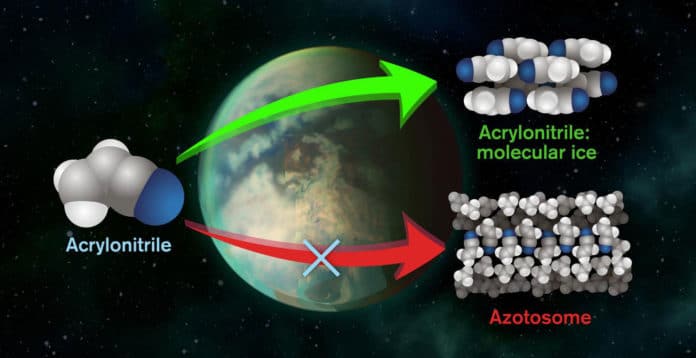Scientists from the Chalmers University of Technology, Sweden, used quantum mechanical calculations and have shown that azotosomes, could not form under the conditions there.
Saturn’s moon Titan features rich atmospheric chemistry and dynamic surface morphology that is driven by seasonal rainfall and cycling of predominately methane and ethane.
The liquids on Titan are not water, yet seas of methane and ethane, and the surface temperature is near – 180C. Lipid membranes, of the sort common to life on Earth, couldn’t work under such conditions.
This has driven specialists searching for indications of life on Titan to think about elective types of cell membranes that could endure these limits. One such elective structure, recommended by a group from Cornell University, is called an ‘azotosome.’
The possibility of azotosomes has picked up traction in the field of astrobiology, and it has been demonstrated computationally that such structures would endure the conditions on Titan. The azotosome was proposed to be formed from the organic compound acrylonitrile – which was later affirmed to exist on Titan.
Utilizing advanced quantum mechanical computations, the scientists compared the energy of the proposed azotosome membrane inserted in methane with that of the molecular crystal form of acrylonitrile – it’s molecular ice. They found that each building block added to the azotosome expanded its vitality altogether, making its formation progressively less likely thermodynamically. They finish up subsequently that while azotosomes could survive on Titan, they would not self-assemble under such conditions. Instead, acrylonitrile would take shape into its molecular ice.
Martin Rahm, Assistant Professor at the Department of Chemistry and Chemical Engineering at the Chalmers University of Technology, said, “Titan is a fascinating place to test our understanding of the limits of prebiotic chemistry – the chemistry that precedes life. What chemical, or possibly biological structures might form, given enough time under such different conditions? The suggestion of azotosomes was an exciting proposal for an alternative to cell membranes as we understand them.”
“But our new research paper shows that, unfortunately, although the structure could indeed tolerate the extremes of Titan, it would not form in the first place.”
“With this work, we hope to contribute to the ongoing discussion on the limits of chemistry and biology in environmental extremes. Though we have shown that acrylonitrile is not a viable building block for workable cell membranes on Titan, we now have a better understanding of the environmental limits for cell membranes. Titan is a highly stimulating and unique environment with many unanswered questions and possibilities left to explore.”
Their work is also a significant step forward in demonstrating the potential of computational astrobiology, which offers the chance to evaluate, before experiments or sampling, whether or not a particular structure or process might be a biosignature, a marker for potential biology.
Their research is published in the journal Science Advances.
